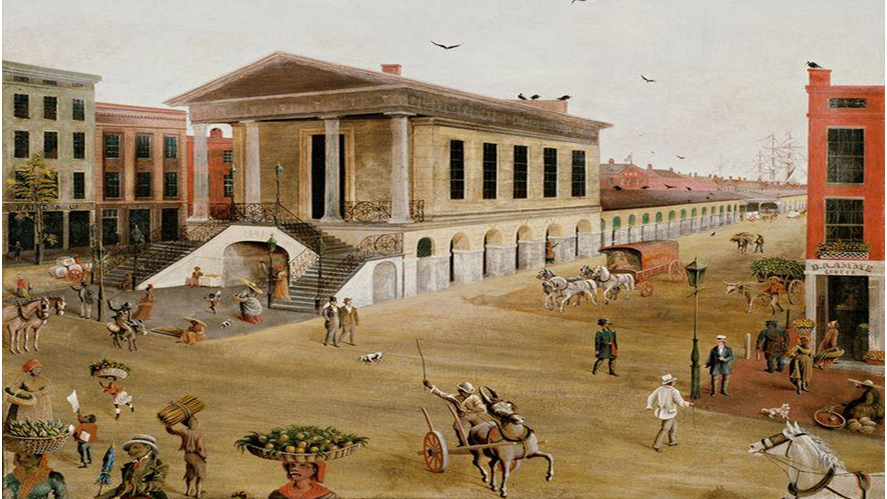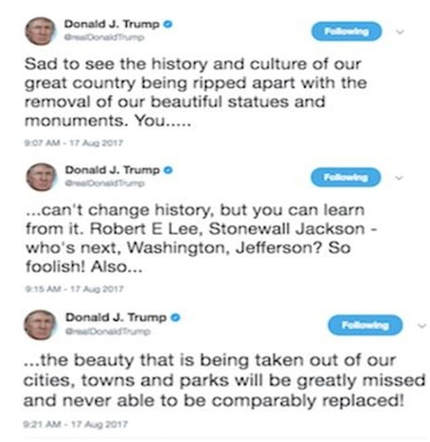|
I grew up in Summerville, South Carolina, just a few miles from historic Charleston. This quiet little town is separated from the Holy City by some plantations, swamps, and marsh but shares the same fascination with local history. Folklore states that Summerville is the birthplace of sweet tea, the source being a newspaper article from 1890 that lists the menu for a Confederate veterans' reunion and included, in addition to jaw-dropping quantities of beef, ham, and bread, “600 pounds of sugar” and "880 gallons of iced tea to wash it down." While the legend has been disputed over the years, the point is that many people in the Charleston area love it here and value their heritage. My experience growing up here cultivated a lifelong interest in all the local history. The area is filled with historic treasures including the first museum in America, the actual remains of the Hunley, as well as countless historic houses and monuments to famous South Carolinians. And I was always taught to appreciate the true diversity within the area. Charleston, in the earliest days, was surrounded by Native American tribes and was home to a variety of groups like English Dissenters, French Huguenots, planters from Barbados, African Slaves, and Scotsmen. Growing up, I appreciated the history local Gullah Culture just as much as the others; I still walk through the streets of Charleston today and see the local Gullah sweetgrass baskets sell for top dollar to tourists flocking into the city for a hospitable experience. As a kid, I watched the Nickelodeon program, Gullah Gullah Island, which was filmed in the area and enjoyed it just as much as any other children’s show. Despite this rich, diverse cultural heritage, many people have become divided over local symbols in the wake of the Emmanuel Nine shooting. While this shooting was certainly a tragedy, we need to focus on ways to bring people together, not divide ourselves based on heritage. Why should any average person, perhaps the average joe without a Southern identity, care at all about this? Our memory of the past helps shape our identity, understand the present, and predict the future. If we are not even allowed to look at, or even talk about our own history - on the land our ancestors bled to defend - we might as well be sheep... Just like London already has done, Charleston, South Carolina is currently implementing technology that will bring the state’s historic memory to life by providing human voices for monuments around the city. Ideally, this will allow people to scan a monument with their phone and listen to a monologue. It seems like a decent idea, on the surface. This project began not long after August 2017, when Charleston Mayor John Tecklenburg released a letter to the city’s Commission on History recommending various changes to the city’s historical markers and stated: “I feel that adding to the historical story enables us to more fully understand and learn from our past.” The changes Tecklenburg recommended include:
The project to create these talking monuments has been called Charleston Stories and it is subtitled Completing the Story: Bringing the Community together. Their website states that they are a “diversified private group of volunteers who are interested in historical accuracy and community harmony” and that their work “aims to lift the public spirit.” But is the goal of this project really to bring people together? Denmark Vesey was a free black man that plotted a massive slave insurrection, and Charleston Stories is giving his monument a voice actor to tell his story and paint him as a symbol for freedom. The irony of this being that Vesey was turned in, and testified against, by other local blacks in Charleston. Meanwhile, some people want the monuments for John C. Calhoun, Wade Hampton, and the Defenders of Charleston get more plaques describing their part in the vast conspiracy of white supremacy. The project even proposed a new, clearly divisive and misleading text for Calhoun’s monument which read: “This monument to John C. Calhoun (1782-1850), erected in 1896, was the culmination of efforts begun in 1858 to commemorate his career. It was erected at a time, after Reconstruction, when most white South Carolinians believed in white supremacy, and the state enacted legislation establishing racial segregation. These ideas are now universally condemned...The statue remains standing today as a reminder that many South Carolinians once viewed Calhoun as worthy of memorialization even though his political positions included his support of race-based slavery, an institution repugnant to the core ideas and values of the United States of America.” This statement was rejected by the locals and sub-committee working on the project, having obviously been not acceptable or objective. Local Charlestonians have gone to great lengths to ensure whatever changes are made will be as unbiased as possible. While the concept of implementing oral history and technology for monuments seems promising, it will take a lot of time and effort from Southerners everywhere to ensure our historic parks are not turned into PC playgrounds. Maybe we could compromise by keeping all the monuments exactly like they are, and add little air-conditioned shacks, complete with coloring books nearby. This will calm all micro-aggressed, triggered snowflakes that simply cannot stand their own history. The South needs to wake up and realize that it’s okay to stand up for our history. A couple of weeks before Tecklenburg’s letter, a Charleston civil rights attorney named Armand Defner said that South Carolina’s Heritage Act is an embarrassment and “makes the state look stupid.” The Heritage Act, which was passed in 2000, protects state and local lands from any change whatsoever without a two-thirds majority vote in both the state Senate and House of Representatives. Defner likened this statute to the 1925 Tennessee vs. Scopes trial and stated “This law makes South Carolina look like a place for yokels, and that’s really unfair to our people.” Finally, Defner argued that The Heritage Act builds artificial barriers, stops dialogue, and discourages participation in the democratic process. It has to be acknowledged that the snowflakes and social justice warriors are the real ones stopping dialogue and creating barriers. They literally make human chains, shout people down, and destroy anything of historic value that they do not agree with. In fact, polls are consistently showing that the majority of voters, many including black Americans, want to keep Confederate monuments as historic symbols. This is why the Left is obsessed with microaggression and agitation. Their movement is so weak in its arguments and logic, that they must resort to tearing down the memories of greater men in order to feel satisfaction. Their only real hope for survival as an ideology is to trigger another Charlottesville, so they can stay relevant. Charleston’s plan to implement mobile technology and make Southern history more accessible is a great idea, and will hopefully get more people interested. But “adding to the historical story,” as Mayor Tecklenburg hopes to do, is not such an easy task. It implies that the actual story is not interesting or dramatic enough. Most people have a hard time seeing past their own biases, let alone those of the private groups and politicians that are trying to alter these monuments. It will take the effort of local communities everywhere, who hold the most important memories, to make sure the real story is being told. Above, two photos of a press conference by the American Heritage Association on October 20, 2018 that called for the candidates for governor to state their position on The Heritage Act. On the left, a photo of the actual crowd supporting the protection of their monuments. On the right, an image from Charleston’s Post and Courier showing less than half the supporters. This distortion is just one small example of how the media has, and will continue to, spin the fight for our heritage.
2 Comments
One of the things that drew me to Donald Trump was his outspoken attitude, commitment to draining the swamp, and his ideas on limiting the government. His inaugural address particularly struck me when he stated: “...we are not merely transferring power from one administration to another, or from one party to another -- but we are transferring power from Washington, D.C. and giving it back to you, the American People.” These promises strongly resonated with working class people everywhere, and are the main reason I will continue to support Trump (as long as he does not invade an American state). But the longer Trump is in office, the more I wonder if he really meant these things, or if he is just a clever shill that sells hats. Here are three reasons that I believe Southerners should be concerned about Trump: 1. HE TOYS WITH THE HEARTSTRINGS OF SOUTHERNERS It's no secret that the South is filled with some of Trump’s biggest supporters. Even though Trump once stated he thought the Confederate flag belongs in a museum, he has been very vocal about the attack on monuments throughout the country. He has referred to the leaders that have taken down monuments as “weak,” and has alluded many times that removing Confederate monuments will lead to the removal of statues of other men like Washington and Jefferson. But what has he really done to open a dialogue or prevent it? Trump has signed at least 77 executive orders since his inauguration, having signed 42 in just his first 200 days. None of them have addressed the monument issue, even though he brings it up frequently. George Washington only signed 8 executive orders in his entire time in office. Will Trump really stand up for American history? 2. SPACE FORCE IS A HOAX? The budget for NASA is right at 19 billion dollars, over 52 million dollars a day. You would think with that kind of money, they would be giving us real pictures and information from space. But in 2012, a NASA data visualizer and designer named Robert Simmon admitted that all the pictures of the Earth since the 1972 are photoshopped because “it has to be.” You can watch that clip here. According to Simmon, most of the known photos of Earth we have seen are composites, made from satellite data and artistic effect. In addition, other well known people within the scientific community are saying that Earth is an oblate spheroid, which is a ball that is wider at the equator than it is at the poles. Neil DeGrasse Tyson has even gone as far as saying that Earth is “pear shaped” and “chubby.” Yet, if you look at all the photos of Earth from NASA, you will see perfect spheres. Something is not adding up. Trump has stated he wants a space force because “Space is a war-fighting domain just like the land, air, and sea.” Why should we be spending money to keep peace in space, when we cannot even manage peace here on Earth? Why should we be sending people to Mars when we have widespread problems here on Earth that still need to be addressed? NASA frequently talks of missions to Mars, yet they have openly admitted many times that we cannot currently go “beyond low earth orbit” in space. Even Obama admitted this in a speech and one astronaut named Don Petit stated we cannot return to the moon because “we destroyed that technology” and its a “painful process to build it back.” The reason is that the Earth is surrounded by the powerful Van Allen radiation belts that we cannot currently penetrate. How did the NASA go the moon six times in the 60’s and 70’s if they can’t go back now? 3. TOO MANY CONTRADICTIONS
Trump, even though he was a wealthy businessman, has always branded himself as more of a “man of the people.” For example, he has likened himself to Andrew Jackson and even talked about how a president like Jackson could have prevented The War Between the States. But in his actions, Trump has been more of a keyboard warrior. Most of his tough talking is done through “tweets.” Andrew Jackson settled his problems like a man and would have preferred being shot dead in a duel over being an internet “tough guy.” While it is clear Trump likes having a direct line to the people, he should pick and choose his battles and should not engage on twitter with every celebrity or athlete that disagrees with him. It’s also clear that Trump is not going to drain the swamp. His promises to investigate and lock up Hillary Clinton were hollow rhetoric aimed at exciting his base. Even if he manages to uproot the corruption in places like the F.B.I., that will not necessarily stop the inherent tendency toward abuse that comes with these institutions. Finally, Trump’s greatest contradiction was the decision to launch a missile attack on Syria. Sources show 59 missiles were launched at Syria in response to their alleged use of chemical weapons on civilians. The most disturbing fact about this is that Trump tweeted his opposition to Obama’s strikes on Syria at least five times. Is it really clear where Trump stands on anything? |
AuthorMichael Martin is a teacher and historian residing in Charleston, South Carolina. He is the author of Southern Grit: Sensing the Siege of Petersburg and his work has been published on The Abbeville Institute, The Imaginative Conservative, and Dixie Heritage. His goal is to shatter the paradigm of centralization and show the world what the Southern Tradition has to offer. Archives
March 2022
|
Proudly powered by Weebly




